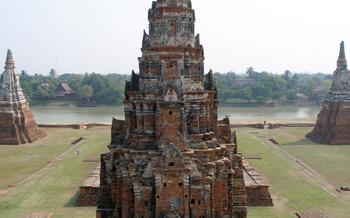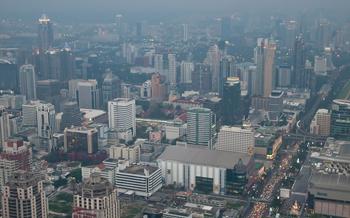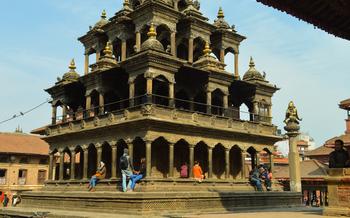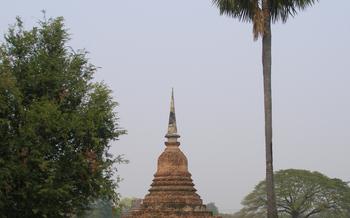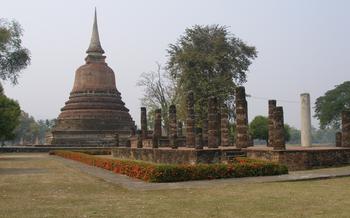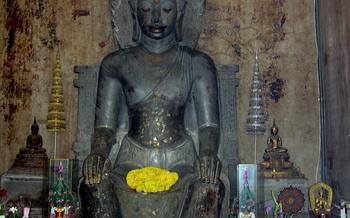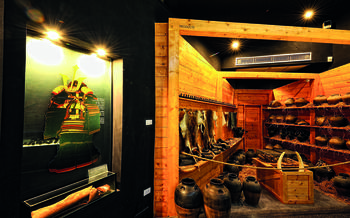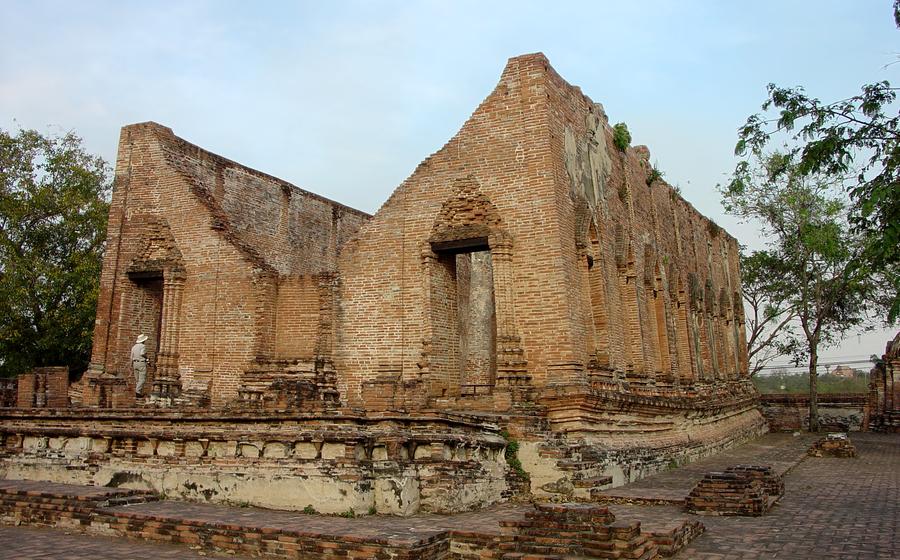
Wat Kudidao
- The Ruins of Wat Kudidao: A Historical Overview
- Location and Accessibility: Finding Your Way to Wat Kudidao
- Exploring the Temple Grounds: Unveiling Hidden Treasures
- The Ordination Hall: A Place of Spiritual Significance
- The Prang: A Symbol of Royal Patronage and Devotion
- The Buddha Statues: Serenity and Devotion in Stone
- The Surrounding Landscape: Nature's Embrace
- Historical and Cultural Insights: Unraveling the Past
- Local Customs and Etiquette: Showing Respect and Courtesy
- Off-the-Beaten-Path Gems: Exploring Beyond the Main Temple
- Photography Opportunities: Capturing the Essence of History
- Combining History with Adventure: Nearby Attractions
- Budget Tips: Exploring Wat Kudidao Affordably
- Local Cuisine: A Culinary Adventure in Ayutthaya
- Insider Tip: Sunrise Serenity
The Ruins of Wat Kudidao: A Historical Overview
Wat Kudidao stands as a testament to the grandeur and artistry of the ancient Ayutthaya Kingdom. Built in the 14th century, this Buddhist temple complex played a crucial role in the religious and cultural life of the kingdom. The temple's unique architectural style, blending Khmer and Thai elements, reflects the rich cultural influences that shaped Ayutthaya. Wat Kudidao's impressive structures, including the ordination hall, the prang, and the Buddha statues, showcase the exceptional craftsmanship and devotion of the era's artisans.
Throughout history, Wat Kudidao underwent several transformations and renovations, adapting to changing times and beliefs. It served as a royal temple, a center for religious ceremonies, and a place of learning for monks and novices. The temple's resilience and significance are evident in its ability to withstand wars, natural disasters, and the passage of time. Today, the ruins of Wat Kudidao stand as a reminder of the kingdom's glorious past and continue to captivate visitors with their historical charm and architectural splendor.
Location and Accessibility: Finding Your Way to Wat Kudidao
Wat Kudidao is situated in the historical city of Ayutthaya, approximately 80 kilometers north of Bangkok, the capital of Thailand. To reach the temple, visitors can take a convenient train ride from Bangkok's Hualamphong Railway Station to Ayutthaya Railway Station. The journey takes about 1 hour and 30 minutes, and tickets can be purchased at the station.
From Ayutthaya Railway Station, visitors can take a tuk-tuk or taxi to Wat Kudidao, which is about 10 kilometers away. The ride takes approximately 20 minutes, and the fare should be around 100-150 baht. Alternatively, visitors can rent a bicycle from one of the many rental shops near the railway station and cycle to the temple, which is a pleasant and eco-friendly option.
For those who prefer a more organized experience, guided tours to Wat Kudidao are available from Ayutthaya and Bangkok. These tours typically include transportation, an English-speaking guide, and a visit to other historical sites in the Ayutthaya region. Booking a guided tour is a great way to learn more about the history and significance of Wat Kudidao and to make the most of your visit.
When planning your visit to Wat Kudidao, it's important to consider the weather conditions. The temple is mostly exposed, so it can get quite hot and humid during the day. It's advisable to visit early in the morning or late in the afternoon to avoid the midday heat. Also, remember to wear comfortable shoes as you'll be doing a lot of walking on uneven surfaces.
Exploring the Temple Grounds: Unveiling Hidden Treasures
Wat Kudidao's temple complex is a treasure trove of architectural wonders and hidden gems. As you step through the gates, you'll be greeted by a sprawling layout of stupas, shrines, and ordination halls, each with its unique story to tell.
Must-see structures include the impressive ordination hall, with its intricate murals and towering Buddha statues, and the iconic prang, a symbol of royal patronage and devotion. Don't miss the smaller shrines scattered throughout the grounds, each housing exquisite Buddha images and offering a glimpse into the temple's rich history.
Keep an eye out for hidden details and unique features as you explore. Look for ancient inscriptions carved into stone, delicate stucco decorations adorning the walls, and remnants of past renovations that tell the story of the temple's evolution over time.
When it comes to photography, Wat Kudidao offers endless opportunities to capture the essence of its ruins. The interplay of light and shadow, the weathered facades, and the lush greenery create a picturesque backdrop for your shots. Experiment with different angles and compositions to reveal the temple's hidden beauty and grandeur.
The Ordination Hall: A Place of Spiritual Significance
The ordination hall, also known as the Ubosot, is the most sacred structure within the Wat Kudidao complex. It is a rectangular building with a distinctive stepped roof and intricately carved wooden gables. The walls are adorned with colorful murals depicting scenes from the life of Buddha and the Jataka tales. The interior of the hall is dominated by a large Buddha statue seated on a lotus pedestal. This statue is considered one of the most important and revered images in Ayutthaya.
The ordination hall is used for a variety of religious ceremonies, including ordinations, weddings, and funerals. It is also a place where monks gather to study and meditate. The hall is open to visitors, but it is important to be respectful of the religious activities that may be taking place. Visitors are expected to remove their shoes before entering the hall and to dress modestly.
One of the most interesting features of the ordination hall is the series of murals that adorn the walls. These murals were painted in the 18th century and depict scenes from the life of Buddha, as well as stories from the Jataka tales. The Jataka tales are a collection of stories about the previous lives of Buddha. The murals are a valuable source of information about Thai art and culture. They are also a testament to the artistic skills of the craftsmen who created them.
The ordination hall at Wat Kudidao is a beautiful and sacred space. It is a place where visitors can learn about Thai history and culture and experience the peace and serenity of Buddhism.
The Prang: A Symbol of Royal Patronage and Devotion
The prang stands tall as a testament to the royal patronage and deep devotion that shaped Wat Kudidao's history. This majestic structure, rising gracefully from the temple grounds, holds profound significance in Thai architecture and symbolism. The prang, also known as the chedi or stupa, represents the sacred Mount Meru, the cosmic center of the universe in Buddhist cosmology.
Crafted with intricate precision, the prang exhibits unique features and decorative elements that captivate the eye. Its graceful curves and tapering form create a sense of upward movement, drawing the viewer's gaze towards the heavens. The surface of the prang is adorned with delicate stuccowork, depicting scenes from Buddhist mythology and the life of the Buddha. These exquisite carvings showcase the artistry and devotion of the ancient craftsmen who painstakingly created them.
The prang underwent meticulous restoration efforts, ensuring its preservation for future generations. These efforts involved careful cleaning and repair of the stuccowork, as well as structural reinforcement to maintain its stability. Through these endeavors, the prang has regained its former glory, standing as a symbol of resilience and the enduring nature of faith.
One of the highlights of the prang is the panoramic view it offers from its summit. Visitors who make the climb to the top are rewarded with breathtaking vistas of the surrounding landscape. The lush greenery of the temple grounds, the meandering waterways, and the distant spires of other temples create a picturesque tableau that captures the essence of Ayutthaya's rich history.
The Buddha Statues: Serenity and Devotion in Stone
Within the temple grounds of Wat Kudidao, visitors will find a diverse collection of Buddha statues, each exuding a sense of serenity and devotion. These statues, crafted in various sizes and styles, hold significant historical and cultural importance, representing the essence of Buddhism in Thailand.
The Buddha images at Wat Kudidao showcase a range of artistic styles, from the iconic Sukhothai period to the more intricate Ayutthaya style. Each statue possesses unique iconographic features, reflecting the beliefs and practices of the era in which it was created.
Visitors can pay respect and offer prayers at the many Buddha shrines scattered throughout the temple complex. These shrines, adorned with offerings of flowers, candles, and incense, provide a glimpse into the deep devotion of the Thai people.
One of the most revered Buddha statues at Wat Kudidao is the Phra Buddha Maha Nawamin, a colossal bronze statue seated in the subduing Mara posture. This grand image, measuring over 19 meters in height, is a testament to the skill and artistry of the ancient Thai craftsmen.
As you admire the Buddha statues at Wat Kudidao, take a moment to reflect on their profound spiritual significance. These serene figures, standing as witnesses to the passage of time, embody the essence of Buddhism and continue to inspire countless devotees to this day.
The Surrounding Landscape: Nature's Embrace
Wat Kudidao is nestled amidst a tranquil and serene landscape, offering a sanctuary of peace and tranquility. Visitors are greeted by lush greenery, towering trees, and meticulously manicured gardens that enhance the temple's spiritual ambiance. The grounds are dotted with colorful flowers, adding a touch of vibrancy to the surroundings. The gentle rustling of leaves and the melodious chirping of birds create a symphony of natural sounds that further enhance the tranquility of the temple. Wildlife enthusiasts may even spot playful squirrels scampering through the trees or graceful birds soaring overhead. Incorporating a leisurely nature walk into your visit allows you to fully embrace the harmonious blend of spirituality and natural beauty that Wat Kudidao offers.
Historical and Cultural Insights: Unraveling the Past
Wat Kudidao stands as a testament to the rich history and culture of Thailand. Over the centuries, the temple has witnessed numerous historical events and legends that have shaped its significance and meaning.
Legends and Folklore:
-
Local folklore tells stories of a giant named "Chao Phraya Phiphit" who is said to have built the temple in a single night.
-
Another legend speaks of a mysterious golden Buddha image that was discovered during the construction of the temple, adding to its sacredness.
Cultural Practices and Traditions:
-
Wat Kudidao has been a center for religious ceremonies and rituals throughout its history.
-
Ordination ceremonies, where young men are initiated into the Buddhist monkhood, are still conducted in the temple's ordination hall.
-
Devotees often visit the temple to pray, make offerings, and seek blessings from the Buddha images.
Ancient Inscriptions and Artifacts:
-
The temple grounds contain ancient inscriptions and artifacts that provide valuable insights into its history and significance.
-
These inscriptions include royal decrees, historical records, and religious texts that shed light on the temple's construction, patronage, and transformations over time.
Understanding the historical and cultural significance of Wat Kudidao enhances the visitor's experience, allowing them to appreciate the temple beyond its architectural beauty and delve into the rich tapestry of Thai history and culture.
Local Customs and Etiquette: Showing Respect and Courtesy
When visiting Wat Kudidao and other sacred sites in Thailand, showing respect for local customs and etiquette is essential. Dress modestly and appropriately, covering your shoulders and knees. Avoid wearing shorts, tank tops, or revealing clothing. When entering the temple grounds, remove your shoes and place them neatly on the designated racks. Respect the monks and other visitors by maintaining a quiet and respectful demeanor. Avoid loud conversations, laughter, or disruptive behavior. If you wish to take photographs, ask permission first and be mindful of not capturing people in prayer or meditation. Remember that Wat Kudidao is an active place of worship, so be considerate of ongoing ceremonies and rituals. By observing local customs and etiquette, you can ensure a respectful and enriching visit to this sacred site.
Off-the-Beaten-Path Gems: Exploring Beyond the Main Temple
While the main temple grounds of Wat Kudidao offer a wealth of historical and architectural wonders, venturing off the beaten path reveals hidden gems that provide a unique perspective on this ancient site. Smaller shrines, stupas, and ruins dot the temple complex, each with its own story to tell. These secluded corners offer tranquility and solitude, allowing visitors to connect with the spiritual essence of the temple in a more intimate setting.
One such hidden gem is a small shrine dedicated to the goddess Phra Mae Thorani. Tucked away among the trees, this shrine exudes a sense of serenity and devotion. The goddess is revered as the earth goddess, representing stability and fertility, and her shrine is a popular spot for locals to come and pray for good fortune and prosperity.
Another off-the-beaten-path highlight is a cluster of ruined stupas located at the far end of the temple grounds. These stupas, once grand and imposing structures, now stand in various states of decay, their crumbling facades hinting at the passage of time. Exploring these ruins offers a glimpse into the temple's rich history and the forces of nature that have shaped it over the centuries.
By venturing beyond the main temple grounds, visitors can uncover the hidden beauty and tranquility of Wat Kudidao. These off-the-beaten-path gems provide a deeper understanding of the temple's significance and offer a unique opportunity to connect with its spiritual essence.
Photography Opportunities: Capturing the Essence of History
Wat Kudidao presents a treasure trove of photographic opportunities for enthusiasts of all levels. The temple's ancient ruins, intricate architecture, and serene ambiance create a captivating backdrop for creative expression.
Ideal Lighting Conditions and Times for Photography
The best time to capture the beauty of Wat Kudidao is during the golden hours of sunrise and sunset. The warm, diffused light casts a magical glow on the ruins, enhancing their textures and details. Alternatively, overcast days can create a moody and atmospheric backdrop, allowing you to experiment with different compositions and exposures.
Compositions and Angles to Highlight the Temple's Unique Features
When composing your shots, consider incorporating leading lines such as pathways, walls, or trees to draw the viewer's eye into the frame. Experiment with different angles to capture unique perspectives of the temple's structures. For instance, shooting from a low angle can emphasize the grandeur of the prang, while a bird's-eye view from the top of the ordination hall can reveal the intricate layout of the temple complex.
Tips for Capturing the Essence and Atmosphere of the Ruins
To truly capture the essence of Wat Kudidao, focus on the details that convey its history and character. Look for weathered surfaces, crumbling brickwork, and overgrown vegetation that tell the story of the temple's passage through time. Experiment with different shutter speeds to convey a sense of movement or stillness, depending on the effect you wish to achieve.
Respecting Photography Guidelines and Restrictions
While photography is generally permitted at Wat Kudidao, it is essential to be respectful of the temple's sacred nature. Avoid using flash photography inside the ordination hall or when photographing monks. Additionally, some areas of the temple may be restricted for photography, so be sure to follow any signage or instructions provided.
Combining History with Adventure: Nearby Attractions
Wat Kudidao stands as a testament to the rich history and cultural heritage of Ayutthaya, inviting visitors to delve into the past. However, the city offers a treasure trove of other historical sites and attractions, providing an opportunity to combine cultural exploration with adventure and excitement. Just a short distance away, visitors can marvel at the grandeur of the ancient city of Ayutthaya, a UNESCO World Heritage Site that boasts impressive temples, palaces, and ruins. The Ayutthaya Historical Park, with its sprawling grounds and well-preserved structures, offers a glimpse into the city's glorious past.
For those seeking a unique experience, a visit to the floating markets of Ayutthaya is a must. These vibrant markets, set on boats along the river, offer a delightful blend of local culture, culinary delights, and traditional crafts. Visitors can savor authentic Thai dishes prepared fresh on the boats, browse local handicrafts, and engage with friendly vendors.
For a touch of adventure, visitors can embark on a cycling tour through the scenic countryside surrounding Ayutthaya. Lush rice fields, tranquil waterways, and charming villages create a picturesque backdrop for a leisurely bike ride. Exploring the countryside by bicycle offers a unique perspective on the region's natural beauty and way of life.
By combining a visit to Wat Kudidao with other historical attractions and activities in Ayutthaya, travelers can create a comprehensive itinerary that caters to their interests and passions. From ancient ruins to vibrant markets and serene countryside landscapes, Ayutthaya offers a diverse range of experiences that will leave a lasting impression on every visitor.
Budget Tips: Exploring Wat Kudidao Affordably
Visiting Wat Kudidao is an enriching experience that doesn't have to break the bank. The temple charges a modest entrance fee, making it accessible to travelers of all budgets. To further save on costs, consider exploring the temple grounds on foot or by bicycle, immersing yourself in the peaceful ambiance while getting some exercise.
When it comes to food, Ayutthaya offers a range of budget-friendly options. Explore the city's vibrant floating markets, where you can savor authentic Thai cuisine at affordable prices. Street food stalls are another great option, offering a variety of delicious dishes to tempt your taste buds.
If you're planning to visit multiple temples in the Ayutthaya region, consider purchasing a temple pass. This pass grants you access to several historical sites at a discounted rate, allowing you to explore the region's rich cultural heritage without breaking the bank.
With careful planning and a bit of savvy, you can easily experience the wonders of Wat Kudidao and the surrounding area without straining your budget. Embrace the opportunity to immerse yourself in Thai history and culture while enjoying a fulfilling and affordable adventure.
Local Cuisine: A Culinary Adventure in Ayutthaya
A visit to Wat Kudidao is not complete without immersing yourself in the culinary delights of Ayutthaya. The city is renowned for its floating markets, where you can savor authentic Thai dishes and local specialties while experiencing the vibrant atmosphere of these unique marketplaces.
For a truly immersive experience, explore the street food stalls that line the streets of Ayutthaya. Here, you can indulge in mouthwatering pad thai, fragrant curries, grilled meats, and refreshing tropical fruits. The aromas, flavors, and colors of these culinary creations will tantalize your taste buds and leave you craving for more.
If you prefer a more refined dining experience, there are several restaurants and eateries near Wat Kudidao that offer a variety of Thai and international cuisines. From traditional Thai dishes to fusion creations, you can find something to satisfy every palate. Be sure to try local favorites such as boat noodles, crispy catfish, and mango sticky rice, which are all culinary emblems of Ayutthaya.
Remember to strike a balance between culinary indulgence and cultural immersion. Take the opportunity to interact with local vendors and learn about the ingredients and cooking techniques used in Thai cuisine. This will not only enhance your culinary experience but also provide a deeper understanding of the local culture and traditions.
Insider Tip: Sunrise Serenity
For an unforgettable and serene experience, visit Wat Kudidao at sunrise. The temple complex comes alive as the first rays of sunlight illuminate the ancient structures, casting a warm golden glow over the ruins. The tranquility of the early morning hours and the absence of crowds create a magical atmosphere, allowing you to fully immerse yourself in the spiritual essence of the place. Capture stunning photographs of the ruins bathed in the soft morning light, creating lasting memories of your visit. Embrace the serenity and peacefulness of this special time, and let the tranquility of Wat Kudidao wash away the stresses of everyday life.
